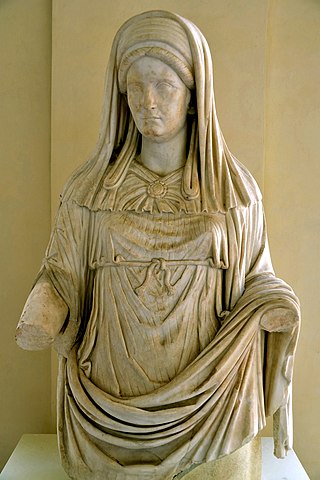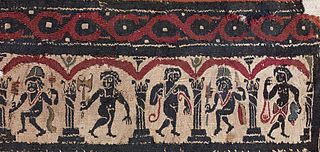
A priest is a religious leader authorized to perform the sacred rituals of a religion, especially as a mediatory agent between humans and one or more deities. They also have the authority or power to administer religious rites; in particular, rites of sacrifice to, and propitiation of, a deity or deities. Their office or position is the 'priesthood', a term which also may apply to such persons collectively. A priest may have the duty to hear confessions periodically, give marriage counseling, provide prenuptial counseling, give spiritual direction, teach catechism, or visit those confined indoors, such as the sick in hospitals and nursing homes.

Proserpina or Proserpine is an ancient Roman goddess whose iconography, functions and myths are virtually identical to those of Greek Persephone. Proserpina replaced or was combined with the ancient Roman fertility goddess Libera, whose principal cult was housed in the Aventine temple of the grain-goddess Ceres, along with the wine god Liber.

Jupiter, also known as Jove, is the god of the sky and thunder, and king of the gods in ancient Roman religion and mythology. Jupiter was the chief deity of Roman state religion throughout the Republican and Imperial eras, until Christianity became the dominant religion of the Empire. In Roman mythology, he negotiates with Numa Pompilius, the second king of Rome, to establish principles of Roman religion such as offering, or sacrifice.

The Bacchanalia were unofficial, privately funded popular Roman festivals of Bacchus, based on various ecstatic elements of the Greek Dionysia. They were almost certainly associated with Rome's native cult of Liber, and probably arrived in Rome itself around 200 BC. Like all mystery religions of the ancient world, very little is known of their rites. They seem to have been popular and well-organised throughout the central and southern Italian peninsula.

In ancient Roman religion, Ceres was a goddess of agriculture, grain crops, fertility and motherly relationships. She was originally the central deity in Rome's so-called plebeian or Aventine Triad, then was paired with her daughter Proserpina in what Romans described as "the Greek rites of Ceres". Her seven-day April festival of Cerealia included the popular Ludi Ceriales. She was also honoured in the May lustration (lustratio) of the fields at the Ambarvalia festival: at harvest-time: and during Roman marriages and funeral rites. She is usually depicted as a mature woman.

In Greek mythology, the satyr Marsyas is a central figure in two stories involving music: in one, he picked up the double oboe (aulos) that had been abandoned by Athena and played it; in the other, he challenged Apollo to a contest of music and lost his hide and life. In antiquity, literary sources often emphasize the hubris of Marsyas and the justice of his punishment.

In ancient Roman religion and mythology, Liber, also known as Liber Pater, was a god of viticulture and wine, male fertility and freedom. He was a patron deity of Rome's plebeians and was part of their Aventine Triad. His festival of Liberalia became associated with free speech and the rights attached to coming of age. His cult and functions were increasingly associated with Romanised forms of the Greek Dionysus/Bacchus, whose mythology he came to share.

Bona Dea was a goddess in ancient Roman religion. She was associated with chastity and fertility in Roman women, healing, and the protection of the state and people of Rome. According to Roman literary sources, she was brought from Magna Graecia at some time during the early or middle Republic, and was given her own state cult on the Aventine Hill.

Mut, also known as Maut and Mout, was a mother goddess worshipped in ancient Egypt and the Kingdom of Kush in present-day North Sudan. In Meroitic, her name was pronounced mata): 𐦨𐦴. Her name means mother in the ancient Egyptian language. Mut had many different aspects and attributes that changed and evolved a lot over the thousands of years of ancient Egyptian culture.

In ancient Rome, the Vestal Virgins or Vestals were priestesses of Vesta, virgin goddess of Rome's sacred hearth and its flame.
An Agonalia or Agonia was an obscure archaic religious observance celebrated in ancient Rome several times a year, in honor of various divinities. Its institution, like that of other religious rites and ceremonies, was attributed to Numa Pompilius, the semi-legendary second king of Rome. Ancient calendars indicate that it was celebrated regularly on January 9, May 21, and December 11.

In ancient Roman religion, the Liberalia was the festival of Liber Pater and his consort Libera. The Romans celebrated Liberalia with sacrifices, processions, ribald and gauche songs, and masks which were hung on trees.

One Virgin Too Many is a 1999 historical mystery crime novel by Lindsey Davis and the 11th book of the Marcus Didius Falco Mysteries series. Set in Rome between 27 May and 7 June AD 74, the novel stars Marcus Didius Falco, informer and imperial agent. The title refers to the Vestal Virgins lottery that is a key plot device.
In classical antiquity, the Juvenalia, or Ludi Juvenales, were scenic games instituted by Nero in 59 AD, at the age of 21, in commemoration of his shaving his beard for the first time, thus indicating that he had passed from youth into manhood. These games were not celebrated in the circus, but in a private theatre erected in a pleasure-ground (nemus), and consisted of every kind of theatrical performance, Greek and Roman plays, mimetic pieces, and the like.

The cult of Dionysus was strongly associated with satyrs, centaurs, and sileni, and its characteristic symbols were the bull, the serpent, tigers/leopards, ivy, and wine. The Dionysia and Lenaia festivals in Athens were dedicated to Dionysus, as well as the phallic processions. Initiates worshipped him in the Dionysian Mysteries, which were comparable to and linked with the Orphic Mysteries, and may have influenced Gnosticism. Orpheus was said to have invented the Mysteries of Dionysus.

In ancient Roman religion, Mutunus Tutunus or Mutinus Titinus was a phallic marriage deity, in some respects equated with Priapus. His shrine was located on the Velian Hill, supposedly since the founding of Rome, until the 1st century BC.

The Aventine Triad is a modern term for the joint cult of the Roman deities Ceres, Liber and Libera. The cult was established ca. 493 BC within a sacred district (templum) on or near the Aventine Hill, traditionally associated with the Roman plebs. Later accounts describe the temple building and rites as "Greek" in style. Some modern historians describe the Aventine Triad as a plebeian parallel and self-conscious antithesis to the Archaic Triad of Jupiter, Mars and Quirinus and the later Capitoline Triad of Jupiter, Minerva and Juno. The Aventine Triad, temple and associated ludi served as a focus of plebeian identity, sometimes in opposition to Rome's original ruling elite, the patricians.
The secespita is a long iron sacrificial knife, made of brass and copper from Cyprus, with a solid and rounded ivory handle, which is secured to the hilt by a ring of silver or gold. The flamens and their wives, the flaminicae, who were priests and priestesses of the Ancient Rome, the virgins and the pontiffs made use of it for sacrifices. This knife derives its name from the Latin verb seco.
Sacerdos Cereris, sacerdos Cerealis or sacerdos Cereris publica was the title of the Priestess of the goddess Ceres in Ancient Rome. It was one of two Roman state cults to include female priests.
Sacerdos Bonae Deae or Damatrix was the title of the Priestess of the goddess Bona Dea in Ancient Rome.









